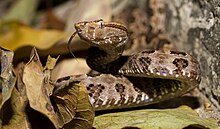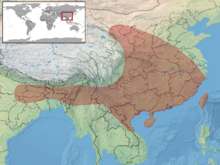Protobothrops mucrosquamatus Contents Description Common names Geographic range See...
IUCN Red List least concern speciesProtobothropsReptiles described in 1839Taxa named by Theodore Edward CantorSnakes of AsiaReptiles of BangladeshReptiles of ChinaReptiles of Hong KongReptiles of IndiaReptiles of LaosReptiles of MyanmarReptiles of TaiwanReptiles of Vietnam
venomouspit viperspeciesendemicAsiasubspecieshemipenesdorsal scalesinternasalssupraocularsinterocularspreocularnasal scaleupper labialssuboculartemporal scalesupper labialsventralssubcaudalsM.A. SmithChineseIndiaAssamBangladeshMyanmarChinaHainanGansuZhejiangLaosVietnamTaiwantype localityNaga HillsOkinawa, Japan
Protobothrops mucrosquamatus | |
|---|---|
 | |
Conservation status | |
 Least Concern (IUCN 3.1)[1] | |
Scientific classification | |
| Kingdom: | Animalia |
| Phylum: | Chordata |
| Class: | Reptilia |
| Order: | Squamata |
| Suborder: | Serpentes |
| Family: | Viperidae |
| Genus: | Protobothrops |
| Species: | P. mucrosquamatus |
Binomial name | |
Protobothrops mucrosquamatus (Cantor, 1839) | |
 | |
Synonyms | |
| |
Protobothrops mucrosquamatus is a venomous pit viper species endemic to Asia. Common names include: brown spotted pit viper,[4] and pointed-scaled pit viper.[5] No subspecies are currently recognized.[6]
Contents
1 Description
2 Common names
3 Geographic range
4 See also
5 References
6 Further reading
Description

Males grow to a maximum total length of 112 cm (44 in) with a tail length of 19.5 cm (7.7 in). Females grow to a maximum total length of 116 cm (46 in) with a tail length of 20.5 cm (8.1 in).[7]
The hemipenes are spinose.[7]
Scalation: dorsal scales in 25 longitudinal rows at midbody; scales on upper surface of head, small, each scale keeled posteriorly; internasals 5–10 times size of adjacent scales, separated by 3–4 scales; supraoculars, long, narrow, undivided, 14–16 small interoculars in line between them; 2 scales on line between upper preocular and nasal scale; 9–11 upper labials, first upper labial separated from nasal by suture; 2–3 small scales between upper labials and subocular; 2–3 rows of temporal scales above upper labials smooth, above those scales keeled; ventrals 200–218; subcaudals 76–91, all paired.[7]
Color pattern: grayish or olive brown above, with dorsal series of large brown, black-edged spots or blotches, and a lateral series of smaller spots; head above brownish, below whitish; belly whitish but heavily powdered with light brown; tail brownish (possibly pink in life [fide M.A. Smith 1943:507]), with series of dark dorsal spots.[7]
Common names
Brown spotted pitviper,[4] pointed-scaled pit viper, habu,[5] Taiwan habu (タイワンハブ), Chinese habu, Formosan pit viper.[8] The Chinese name is 龜殼花蛇 or 原矛头蝮.
Geographic range
Found from northeastern India (Assam) and Bangladesh, to Myanmar, China (including Hainan, and as far north as Gansu and as far east as Zhejiang), Laos, northern and central Vietnam, as well as in Taiwan. The type locality given is "Naga Hills" (India).[2][3] This snake is introduced to Okinawa, Japan.
See also
- List of crotaline species and subspecies
- Snakebite
References
^ Papenfuss, T.J. (2010). "Protobothrops mucrosquamatus". The IUCN Red List of Threatened Species. IUCN. 2010: e.T178409A7540882. doi:10.2305/IUCN.UK.2010-4.RLTS.T178409A7540882.en. Retrieved 15 January 2018..mw-parser-output cite.citation{font-style:inherit}.mw-parser-output .citation q{quotes:"""""""'""'"}.mw-parser-output .citation .cs1-lock-free a{background:url("//upload.wikimedia.org/wikipedia/commons/thumb/6/65/Lock-green.svg/9px-Lock-green.svg.png")no-repeat;background-position:right .1em center}.mw-parser-output .citation .cs1-lock-limited a,.mw-parser-output .citation .cs1-lock-registration a{background:url("//upload.wikimedia.org/wikipedia/commons/thumb/d/d6/Lock-gray-alt-2.svg/9px-Lock-gray-alt-2.svg.png")no-repeat;background-position:right .1em center}.mw-parser-output .citation .cs1-lock-subscription a{background:url("//upload.wikimedia.org/wikipedia/commons/thumb/a/aa/Lock-red-alt-2.svg/9px-Lock-red-alt-2.svg.png")no-repeat;background-position:right .1em center}.mw-parser-output .cs1-subscription,.mw-parser-output .cs1-registration{color:#555}.mw-parser-output .cs1-subscription span,.mw-parser-output .cs1-registration span{border-bottom:1px dotted;cursor:help}.mw-parser-output .cs1-ws-icon a{background:url("//upload.wikimedia.org/wikipedia/commons/thumb/4/4c/Wikisource-logo.svg/12px-Wikisource-logo.svg.png")no-repeat;background-position:right .1em center}.mw-parser-output code.cs1-code{color:inherit;background:inherit;border:inherit;padding:inherit}.mw-parser-output .cs1-hidden-error{display:none;font-size:100%}.mw-parser-output .cs1-visible-error{font-size:100%}.mw-parser-output .cs1-maint{display:none;color:#33aa33;margin-left:0.3em}.mw-parser-output .cs1-subscription,.mw-parser-output .cs1-registration,.mw-parser-output .cs1-format{font-size:95%}.mw-parser-output .cs1-kern-left,.mw-parser-output .cs1-kern-wl-left{padding-left:0.2em}.mw-parser-output .cs1-kern-right,.mw-parser-output .cs1-kern-wl-right{padding-right:0.2em}
^ ab McDiarmid RW, Campbell JA, Touré T. 1999. Snake Species of the World: A Taxonomic and Geographic Reference, Volume 1. Herpetologists' League. 511 pp.
ISBN 1-893777-00-6 (series).
ISBN 1-893777-01-4 (volume).
^ ab Protobothrops mucrosquamatus at the Reptarium.cz Reptile Database. Accessed 2 February 2017.
^ ab Gumprecht A, Tillack F, Orlov NL, Captain A, Ryabov S. 2004. Asian Pitvipers. Geitje Books. Berlin. 1st Edition. 368 pp.
ISBN 3-937975-00-4.
^ ab U.S. Navy. 1991. Poisonous Snakes of the World. US Govt. New York: Dover Publications Inc. 203 pp.
ISBN 0-486-26629-X.
^ "Trimeresurus mucrosquamatus". Integrated Taxonomic Information System. Retrieved 25 May 2007.
^ abcd Leviton, A.E.; Wogan, G.O.U.; Koo, M.S.; Zug, G.R.; Lucas, R.S. & Vindum, J.V. (2003). "The dangerously venomous snakes of Myanmar. Illustrated checklist with keys" (PDF). Proceedings of the California Academy of Sciences. 54 (24): 407–462.
^ Brown JH. 1973. Toxicology and Pharmacology of Venoms from Poisonous Snakes. Springfield, Illinois: Charles C. Thomas. 184 pp. LCCCN 73-229.
ISBN 0-398-02808-7.
Further reading
.mw-parser-output .refbegin{font-size:90%;margin-bottom:0.5em}.mw-parser-output .refbegin-hanging-indents>ul{list-style-type:none;margin-left:0}.mw-parser-output .refbegin-hanging-indents>ul>li,.mw-parser-output .refbegin-hanging-indents>dl>dd{margin-left:0;padding-left:3.2em;text-indent:-3.2em;list-style:none}.mw-parser-output .refbegin-100{font-size:100%}
Boulenger, G.A. 1890. The Fauna of British India, Including Ceylon and Burma. Reptilia and Batrachia. Secretary of State for India in Council. (Taylor and Francis, Printers.) London. xviii + 541 pp. (Trimeresurus mucrosquamatus, p. 428.)
Cantor, T.E. 1839. Spicilegium Serpentium Indicorum [parts 1 and 2]. Proc. Zool. Soc. London, Part VII 1839: 31-34, 49-55.- Kraus, Fred; Mink, Daniel G.; & Brown, Wesley M. 1996. Crotaline intergeneric relationships based on mitochondrial DNA sequence data. Copeia 1996 (4): 763-773.
Smith, M.A. 1943. The Fauna of British India, Ceylon and Burma, Including the Whole of the Indo-Chinese Sub-region. Reptilia and Amphibia. Vol. III.—Serpentes. Secretary of State for India. (Taylor and Francis, Printers.) London. xii + 583 pp. (Trimeresurus mucrosquamatus, pp. 507–508.)- Tu, M.-C. et al. 2000 Phylogeny, Taxonomy, and Biogeography of the Oriental Pit Vipers of the Genus Trimeresurus (Reptilia: Viperida Crotalinae): A Molecular Perspective. Zoological Science 17: 1147-1157.
